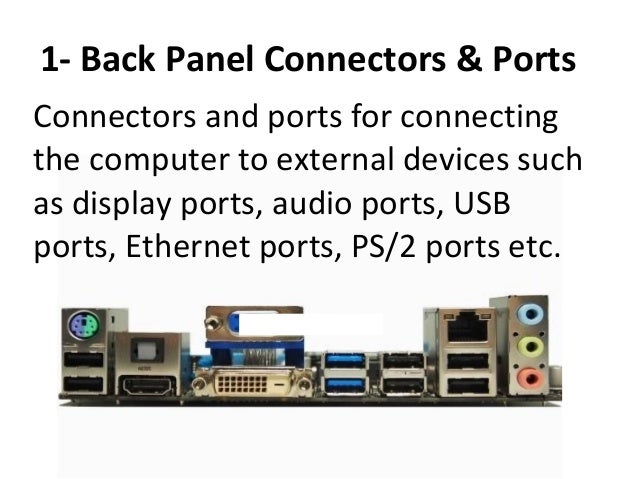Functions Of Expansion Slots
ISA Expansion Slots
An expansion slot is a socket on the motherboard that can hold an adapter card. An adapter card, sometimes called an expansion card, is a circuit board that enhances functions of a component of the system unit and/or provides a connection to a peripheral. A sound card enhances the sound-generating capabili- ties of a personal computer. The expansion slots on a motherboard provide us with almost unlimited options for customizing our computers. In this video, you’ll learn about the PCI bus, the PCI Express bus, and riser cards. You can extend the functionality of a motherboard by adding adapter cards.

The computer made before 1997, the motherboard has a few ISA, Industry Standard Architecture, expansion slots. They're easily recognizable because they are usually black and have two parts: one shorter and one longer. Computers made after 1997 generally include a few ISA slots for backward compatibility with old expansion cards.
PCI Expansion Slots
Most computers made today contain primarily PCI, Peripheral Component Interconnect, slots. They are easily recognizable because they are short (around 3 inches long) and usually white. PCI slots can usually be found in any computer that has a Pentium-class processor orhigher.
AGP Expansion Slots
AGP, Accelerated Graphics Port, slots are very popular for video card use. In the past, if you wanted to use a high-speed, accelerated 3D graphics video card, you had to install the card into an existing PCI or ISA slot. AGP slots were designed to be a direct connectionbetween the video circuitry and the PC's memory. It uses the northbridge bus so it is very fast. They are also easily recognizable because they are usually brown, are located right next to the PCI slots on the motherboard, and are shorter than the PCI slots.
PCIe Expansion Slots
PCIe X1
PCIe X4
PCIe X8 and 16
The newest expansion slot architecture that is being used by motherboards is PCI Express (PCIe). It was designed to be a replacement for AGP and PCI. It has the capability of being faster than AGP while maintaining the flexibility of PCI. It also uses the northbridge bus. And motherboards with PCIe will have regular PCI slots for backward compatibility with PCI.
There are seven different speed levels for PCIe, and they are designated 1X, 2X, 4X, 8X, 12X, 16X, and 32X. These designations roughly correspond to similarly designated AGP speeds. The slots for PCIe are a bit harder to identify than other expansion slot types becausethe slot size corresponds to its speed. For example, the 1X slot is extremely short (less than an inch). The slots get longer in proportion to the speed; the longer the slot, the higher the speed. The reason for this stems from the PCIe concept of lanes, which are the multiplied units of communication between any two PCIe components and are directly related to physical wiring on the bus. Because all PCIe communications are made up of unidirectional coupling between devices, each PCIe card negotiates for the best mutually supported number of lanes with each communications partner.
AMR Expansion Slots
As is always the case, Intel and other manufacturers are constantly looking for ways to improve the production process. One lengthy process that would often slow down the production of motherboards with integrated analog I/O functions was FCC certification. The manufacturers developed a way of separating the analog circuitry, for example, modem and analog audio, onto its own card. This allowed the analog circuitry to be separately certified (it was its own expansion card), thus reducing time for FCC certification. This slot and riser card technology was known as the Audio Modem Riser, or AMR. AMR¡¯s 46-pin slots were once fairly common on many Intel motherboards, but technologies including CNR and Advanced Communications Riser (ACR) are edging out AMR. In addition and despite FCC concerns, integrated components still appear to be enjoying the most success comparatively.
CNR Expansion Slots
CNR, Communications and Networking Riser, slots that can be found on some Intel motherboards are a replacement for Intel's AMR slots. Essentially, these 60-pin slots allow a motherboard manufacturer to implement a motherboard chipset with certain integrated features. Then, if the built-in features of that chipset need to be enhanced (by adding Dolby Digital Surround to a standard sound chipset, for example), a CNR riser card could be added to enhance the onboard capabilities. Additional advantages of CNR over AMR include networking support, Plug and Play compatibility, support for hardware acceleration (as opposed to CPU control only), and no need to lose a competing PCI slot unless the CNR slot is in use.
SATA Expansion Slots
Functions Of Expansion Slots On The Motherboard
SATA is a new standard for connecting hard drives into computer systems. As its name implies, SATA is based on serial signaling technology, unlike current IDE (Integrated Drive Electronics) hard drives that use parallel signaling.
SATA has several practical advantages over the parallel signaling (also called Parallel ATA or PATA) that has been used in hard drives since the 1980s. SATA cables are more flexible, thinner, and less massive than the ribbon cables required for conventional PATA hard drives. SATA cables can be considerably longer than PATA ribbon cables, allowing the designer more latitude in the physical layout of a system. Because there are fewer conductors (only 7 in SATA as compared with 40 in PATA), crosstalk and electromagnetic interference (EMI) are less likely to be troublesome. The signal voltage is much lower as well (250 mV for SATA as compared with 5 V for PATA).
SCSI Expansion Slots
Function Of Expansion Slots
SCSI, Small Computer Serial Interface, is a series of interface standards for disk drives and other peripherals, usually offering better performance than the IDE interface standard in PCs but with more complexity and at higher cost.